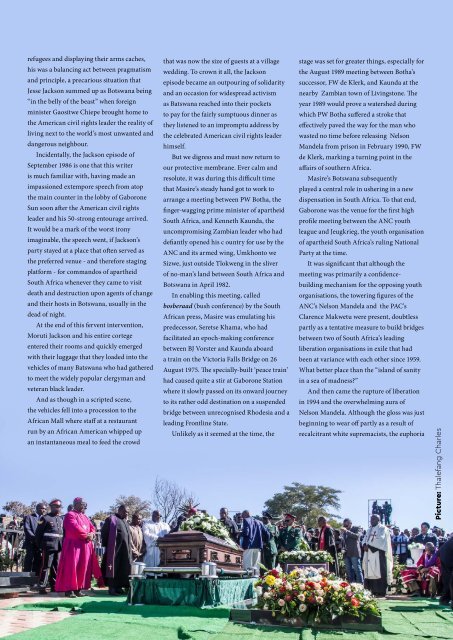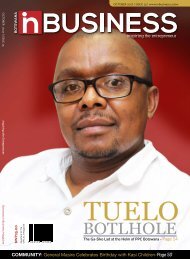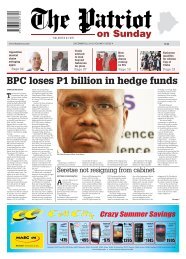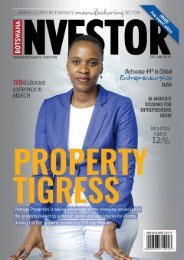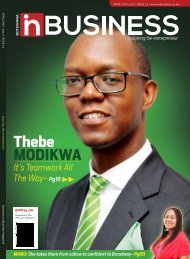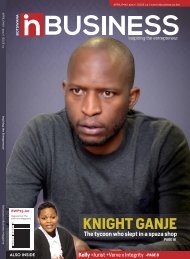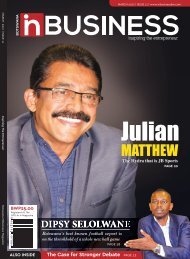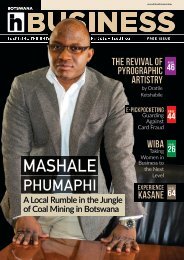inBUSINESS Issue 14
Create successful ePaper yourself
Turn your PDF publications into a flip-book with our unique Google optimized e-Paper software.
efugees and displaying their arms caches,<br />
his was a balancing act between pragmatism<br />
and principle, a precarious situation that<br />
Jesse Jackson summed up as Botswana being<br />
“in the belly of the beast” when foreign<br />
minister Gaositwe Chiepe brought home to<br />
the American civil rights leader the reality of<br />
living next to the world’s most unwanted and<br />
dangerous neighbour.<br />
Incidentally, the Jackson episode of<br />
September 1986 is one that this writer<br />
is much familiar with, having made an<br />
impassioned extempore speech from atop<br />
the main counter in the lobby of Gaborone<br />
Sun soon after the American civil rights<br />
leader and his 50-strong entourage arrived.<br />
It would be a mark of the worst irony<br />
imaginable, the speech went, if Jackson’s<br />
party stayed at a place that often served as<br />
the preferred venue - and therefore staging<br />
platform - for commandos of apartheid<br />
South Africa whenever they came to visit<br />
death and destruction upon agents of change<br />
and their hosts in Botswana, usually in the<br />
dead of night.<br />
At the end of this fervent intervention,<br />
Moruti Jackson and his entire cortege<br />
entered their rooms and quickly emerged<br />
with their luggage that they loaded into the<br />
vehicles of many Batswana who had gathered<br />
to meet the widely popular clergyman and<br />
veteran black leader.<br />
And as though in a scripted scene,<br />
the vehicles fell into a procession to the<br />
African Mall where staff at a restaurant<br />
run by an African American whipped up<br />
an instantaneous meal to feed the crowd<br />
that was now the size of guests at a village<br />
wedding. To crown it all, the Jackson<br />
episode became an outpouring of solidarity<br />
and an occasion for widespread activism<br />
as Batswana reached into their pockets<br />
to pay for the fairly sumptuous dinner as<br />
they listened to an impromptu address by<br />
the celebrated American civil rights leader<br />
himself.<br />
But we digress and must now return to<br />
our protective membrane. Ever calm and<br />
resolute, it was during this difficult time<br />
that Masire’s steady hand got to work to<br />
arrange a meeting between PW Botha, the<br />
finger-wagging prime minister of apartheid<br />
South Africa, and Kenneth Kaunda, the<br />
uncompromising Zambian leader who had<br />
defiantly opened his c ountry for use by the<br />
ANC and its armed wing, Umkhonto we<br />
Sizwe, just outside Tlokweng in the sliver<br />
of no-man’s land between South Africa and<br />
Botswana in April 1982.<br />
In enabling this meeting, called<br />
bosberaad (bush conference) by the South<br />
African press, Masire was emulating his<br />
predecessor, Seretse Khama, who had<br />
facilitated an epoch-making conference<br />
between BJ Vorster and Kaunda aboard<br />
a train on the Victoria Falls Bridge on 26<br />
August 1975. The specially-built ‘peace train’<br />
had caused quite a stir at Gaborone Station<br />
where it slowly passed on its onward journey<br />
to its rather odd destination on a suspended<br />
bridge between unrecognised Rhodesia and a<br />
leading Frontline State.<br />
Unlikely as it seemed at the time, the<br />
stage was set for greater things, especially for<br />
the August 1989 meeting between Botha’s<br />
successor, FW de Klerk, and Kaunda at the<br />
nearby Zambian town of Livingstone. The<br />
year 1989 would prove a watershed during<br />
which PW Botha suffered a stroke that<br />
effectively paved the way for the man who<br />
wasted no time before releasing Nelson<br />
Mandela from prison in February 1990, FW<br />
de Klerk, marking a turning point in the<br />
affairs of southern Africa.<br />
Masire’s Botswana subsequently<br />
played a central role in ushering in a new<br />
dispensation in South Africa. To that end,<br />
Gaborone was the venue for the first high<br />
profile meeting between the ANC youth<br />
league and Jeugkrieg, the youth organisation<br />
of apartheid South Africa’s ruling National<br />
Party at the time.<br />
It was significant that although the<br />
meeting was primarily a confidencebuilding<br />
mechanism for the opposing youth<br />
organisations, the towering figures of the<br />
ANC’s Nelson Mandela and the PAC’s<br />
Clarence Makwetu were present, doubtless<br />
partly as a tentative measure to build bridges<br />
between two of South Africa’s leading<br />
liberation organisations in exile that had<br />
been at variance with each other since 1959.<br />
What better place than the “island of sanity<br />
in a sea of madness?”<br />
And then came the rupture of liberation<br />
in 1994 and the overwhelming aura of<br />
Nelson Mandela. Although the gloss was just<br />
beginning to wear off partly as a result of<br />
recalcitrant white supremacists, the euphoria<br />
Picture: Thalefang Charles<br />
www.inbusiness.co.bw | <strong>Issue</strong> <strong>14</strong> | 2017 23


